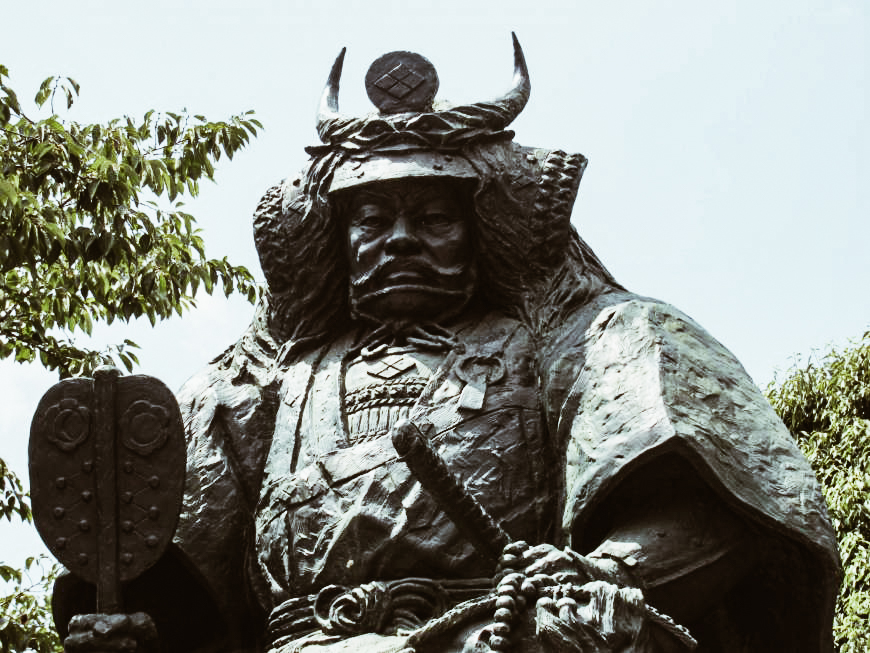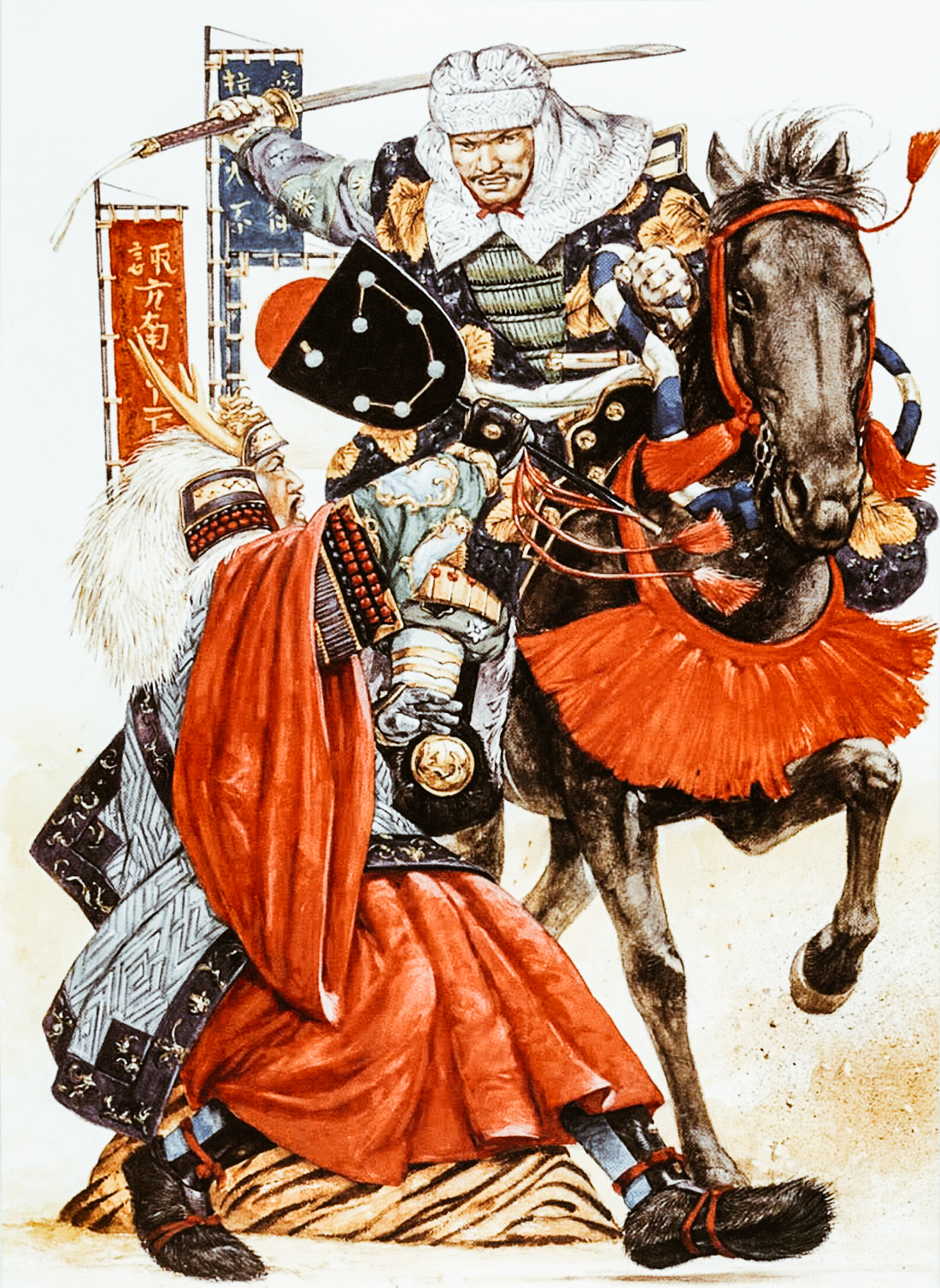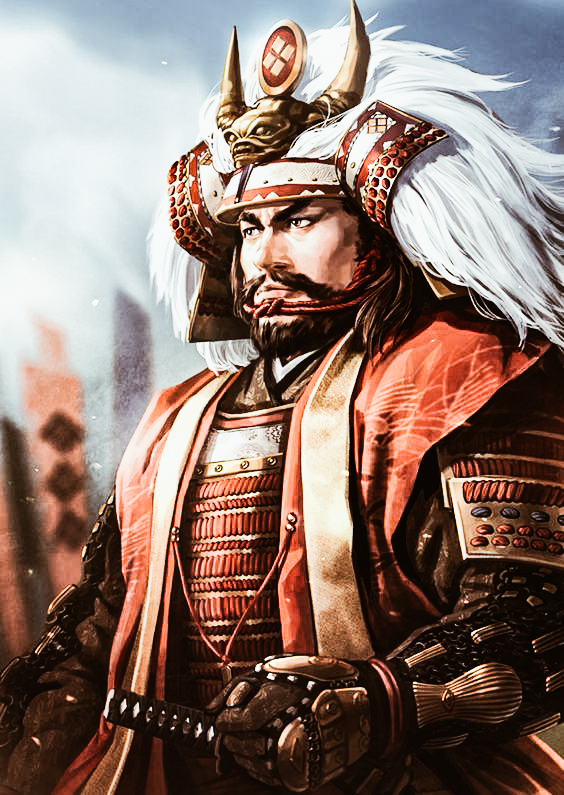Japan History: Takeda Shingen
Takeda Shingen (Takeda Harunobu 1 ° dicembre 1521 – 13 maggio 1573), primogenito del signore della guerra Takeda Nobutora, nacque nel potente clan Takeda. Egli era Shugo Daimyo (governatori militari) dell’allora provincia di Kai, attuale prefettura di Yamanashi.
Takeda Shingen ebbe un ruolo molto importante nella battaglia di Un no Kuchi nel 1536, a soli 15 anni. Quando suo padre designò il suo secondo figlio come erede, Shingen condusse un colpo di stato senza spargimento di sangue. Questo costrinse il padre a ritirarsi come capo del clan. Successivamente, Shingen iniziò ad espandere i domini della sua famiglia verso nord nella provincia di Shinano (attuale prefettura di Nagano) e in terre adiacenti a Kai.
Come capo indiscusso del clan Takeda, iniziò la sua politica espansionistica partendo dalla Battaglia di Sezawa. Proseguì poi con gli assedi di Uehara, Kuwabara e Fukuyo, le battaglie di Ankokuji, Odaihara, Shiojiritoge, e la serie di Battaglie di Kawanakajima contro Uesugi Kenshin.
Shingen decise di far indossare a tutti i guerrieri un’armatura rossa laccata nelle prime linee dei suoi eserciti per intimidire psicologicamente il nemico. Questa idea fu anche successivamente copiata dal clan dell’esercito Tokugawa.

photo credits: japantimes.co.jp
La vita di Takeda Shingen
Nel 1548 Takeda Shingen sconfisse Ogasawara Nagatoki nella battaglia di Shiojiritōge e prese Fukashi nel 1550. Uesugi Kenshin scese in campo in quel momento poiché i Takeda erano ormai giunti ai confini della sua provincia.
Quella che iniziò fu una rivalità che diventerà leggendaria e che li portò a scontrarsi nelle battaglie di Kawanakajima. Queste battaglie furono generalmente delle schermaglie, infatti nessuno dei due daimyō voleva scoprirsi in una battaglia a tutto campo.
La battaglia più feroce tra i due fu la quarta, durante la quale, secondo la leggenda, Uesugi Kenshin riuscì ad aprirsi un varco tra le linee Takeda e affrontò Shingen. Si narra che Kenshin attaccò Shingen con la sua spada difendendosi con il suo ventaglio (o tessen). Entrambi persero numerosi uomini durante la battaglia. In particolare Shingen perse due importanti generali, Yamamoto Kansuke e suo fratello più giovane Takeda Nobushige.
Takeda Shingen entrò nel sacerdozio nel 1551, momento in cui assunse il nome buddista Shingen. Tuttavia, prendere i voti religiosi non impedì in alcun modo la sua partecipazione agli affari mondani.
Dopo la quarta battaglia, Shingen scoprì due complotti alla sua vita. Il primo da parte di suo cugino Suwa Shigemasa, al quale fu ordinato di commettere seppuku. Mentre il secondo, qualche anno più tardi da suo figlio Takeda Yoshinobu. Quest’ultimo fu esiliato presso il tempio Toko, dove morì due anni dopo forse per ordine del padre. Dopo questo incidente, Shingen designò il suo quartogenito, Katsuyori come successore alla guida del clan.
Dopo aver conquistato Katsurao, Wada, Takashima e Fukuda, nel 1554 riportò altrettante vittorie negli assedi di Fukushima, Kannomine, Matsuo e Yoshioka.
Nel 1563, insieme a Hōjō Ujiyasu, Takeda Shingen conquistò il castello di Matsuyama nella provincia di Musashi. Successivamente ottenne il possesso di Kuragano nel 1565 e del castello di Minowa. Poi si mosse contro gli Hōjō attaccando il castello di Hachigata.
Si ritirò con successo dopo che Hōjō Ujiteru e Hōjō Ujikuni fallirono il tentativo di fermarlo nella battaglia di Mimasetōge.

photo credits: pinimg.com
La principale ambizione di Harunobu era la sottomissione di Shinano. Tuttavia, la resistenza in quel quartiere fu feroce. Un certo numero di signori della guerra Shinano, tra cui Murakami Yoshikiyo, Ogasawara Nagatoki, Suwa Yorishige e Kiso Yoshiyasu, fecero una mossa progettata per sperare di troncare sul nascere un’ulteriore aggressione Takeda.
La marcia verso il confine del Kai
Nell’aprile del 1542 i quattro daimyo combinarono le forze e marciarono verso il confine di Kai, incoraggiati dalla notizia che Harunobu stava rafforzando le sue difese e si preparava a prendere posizione a Fuchu. In effetti, le attività di Harunobu furono uno stratagemma. Lungi dall’attendere passivamente a Kai, Harunobu guidò i suoi uomini e colse di sorpresa i guerrieri Shinano, sconfiggendoli a Sezawa.
Incoraggiato dai risultati di Sezawa, Harunobu fece un viaggio a Shinano concentrandosi sul territorio del clan Suwa. Prese prima Uehara in un attacco a sorpresa e poi si trasferì nel quartier generale di Suwa a Kuwahara, situato a 2 chilometri a est. Suwa Yorishige non ebbe altra scelta che arrendersi in seguito alla promessa di condotta sicura da parte di Harunobu. Yorishige e suo fratello furono portati a Kai dove il generale Takeda, Itagaki Nobutaka, organizzò la loro morte. Entrambi i Suwa si suicidarono.

photo credits: pinterest.it
Harunobu, con l’aiuto delle strategie di Yamamoto Kansuke, espanse ulteriormente il suo territorio attraverso la sconfitta di Tozawa Yorichika e Takato Yoritsugu. L’acquisizione del castello di Takato fu di particolare valore. Infatti, essa fornì una zona di sosta sicura nel sud di Shinano, nonché un cuscinetto contro qualsiasi aggressione meridionale.
Nel 1544 i Takeda marciarono verso Suruga a sostegno dell’Imagawa e affrontarono Hôjô Ujiyasu. Non avvenne alcun conflitto reale a seguito di questo scontro. Harunobu fu infatti costretto a stipulare un trattato di pace tra Hōjō e Imagawa.
Nel corso del decennio successivo, Harunobu continuò a esercitare una pressione incessante sui signori della guerra Shinano. Nel 1548 Murakami Yoshikiyo, forse il più formidabile nemico Shinano di Harunobu, si spostò su Ueda e sconfisse il clan Takeda in un aspro scontro. Qui vennero usati un certo numero di archibugi cinesi, le prime armi del genere mai schierate in una battaglia giapponese. Mentre la sconfitta di Uehara lasciava morti due dei suoi migliori generali, Harunobu rimbalzò rapidamente. Infatti, nel 1552 i clan Murakami e Ogasawara fuggirono da Shinano a Echigo.
Takeda Shingen vs Uesugi Kenshin
Nel giugno e nell’ottobre del 1553 gli eserciti Takeda e Uesugi si scontrarono vicino alla pianura Kawanakajima nel nord di Shinano. Uno scontro durato cinque volte ma solo la quarta battaglia produsse una gara a tutto campo. Entrambe le parti subirono pesanti perdite che rallentarono entrambi i signori della guerra per alcuni anni. In particolare, Shingen deve aver risentito della perdita di Nobushige e Yamamoto Kansuke, entrambi deceduti nella battaglia.
Nel 1560 Shingen aveva scoperto un complotto contro di lui guidato da sua cugina Katanuma Nobumoto e nel 1565 quello diretto da suo figlio Yoshinobu e Obu Toramasa. Due anni dopo Yoshinbou morì. Leggenda dice che la morte sia dovuta o a malattia o, come molti credono, perché Shingen lo aveva costretto a suicidarsi. L’evento lasciò i servitori di Takeda a disagio.

photo credits: wikipedia.org
Nel 1564, Shingen aveva sottomesso tutto Shinano e spostato la sua attenzione su Kōzuke, dove prese un certo numero di castelli dal clan Uesugi. Per i successivi cinque anni, si limitò alle incursioni e alle conquiste locali, concentrandosi sugli affari interni.
Nel 1560, il più grande successo di Shingen fu il progetto di Damji River Damming. Il beneficio del progetto del fiume Fuji è considerato una delle più grandi iniziative nazionali del XVI secolo.
Nel 1568, l’esercito di Takeda era di nuovo in movimento, questa volta a sud contro Imagawa. Il daimyō di quel clan era Ujizane, il figlio incompetente del defunto Imagawa Yoshimoto (ucciso nel 1560 da Oda Nobunaga). Yoshinobu, figlio di Shingen, aveva sposato la sorella di Ujizane, ma dopo il suicidio della stessa nel 1567, i rapporti tra le famiglie si erano acuiti. Sembrerebbe che Shingen e Tokugawa Ieyasu avessero stipulato un accordo in base al quale i due avrebbero diviso le terre rimanenti dell’Imagawa (Tōtōmi e Suruga). Tuttavia, questo accordo non fu mai portato a compimento. Inoltre, l’Hōjō di Sagami non vedeva di buon grado questo spostamento nell’equilibrio del potere. A causa di ciò, inviò le truppe a sfidare Shingen. Nel 1569 Shingen rispose invadendo Sagami e assediando Odawara (la capitale dell’Hōjō). Tuttavia, sulla via del ritorno a Kai, l’esercito Takeda riuscì a schiacciare un tentativo di agguato da parte di Mimasetoge di Hōjō.
Così, nel 1570, le terre di Takeda includevano Kai, Shinano, Suruga e pezzi di Kozuke, Tōtōmi e Hida. Shingen, a 49 anni, era ormai più di un potere regionale. Takeda Shingen era di fatto il più importante signore della guerra a est di Mino. Inoltre, fu l’unico in grado di far deragliare la marcia di Oda Nobunaga all’egemonia nazionale. Solo Shingen possedeva la posizione strategica e le forze armate per fermarlo.
Nel 1570 morì il formidabile Hōjō Ujiyasu e il suo erede, Ujimasa, fece pace con Shingen. Questo fu un atto che avrebbe potuto assicurare la distruzione definitiva di Tokugawa Ieyasu. Tuttavia, Shingen morì nel 1573 mandando i piani in fumo.
Il clan Takeda si allea con il clan Oda
Nel frattempo, i Takeda e gli Oda, puntavano al controllo del clan Uesugi. Dopo un corteggiamento diplomatico fallito, essi avviarono una guerra di parole con lo shogun Ashikaga Yoshiaki.
Shingen intensificò la pressione contro Tokugawa e nel 1572 lanciò un attacco a Tōtōmi che portò alla cattura di Futamata. Il seguente gennaio, Shingen ritornò nella provincia e attirò Tokugawa Ieyasu nella Battaglia di Mikatagahara. Condotta il 6 gennaio a nord di Hamamatsu, si concluse con una sconfitta quasi completa per Ieyasu.
Sebbene fossero spesso presentate come mosse iniziali in una marcia su Kyōto, le intenzioni di Shingen erano senza dubbio più conservative. Probabilmente, Takeda Shingen mirava a testare le risposte sia di Ieyasu che di Nobunaga e, se possibile, infliggere ai due una sconfitta. In ogni caso, entro pochi giorni dalla vittoria della battaglia, ricevette la notizia che Asakura Yoshikage aveva scelto di non opporsi a Nobunaga. Shingen rimase dispiaciuto, e avrebbe potuto contare su Yoshikage per mantenere la tensione su Nobunaga. Questo potrebbe aver giocato un ruolo nella sua decisione di tornare a Kai garantendo così una tregua al sanguinario Tokugawa.
La figura di Takeda Shingen
Shingen era una figura complicata, a volte assolutamente crudele. All’inizio della sua vita, aveva costretto Suwa Yorishige a suicidarsi (o lo aveva assassinato) dopo che i due signori della guerra avevano firmato un trattato di pace. Successivamente prese la figlia di Suwa come amante, ignorando il fatto che lei fosse tecnicamente la sua stessa nipote .
Apparentemente Shingen creò lo Shingen Tsuba, (la guardia della spada) noto anche come Takeda Tsuba. La storia racconta che mentre aspettava l’inizio di una battaglia, Shingen avvolgeva il filo di ottone attorno a un grande sukashi di ferro per tenersi concentrato e capace di pensare fino a quando la battaglia aveva inizio. A causa di ciò, molti dei suoi vassalli seguirono la guida di Shingen per tutto il periodo Edo.
È anche accreditato di aver inventato lo scarico del water, l’igiene del bagno, a quanto pare, era importante per Shingen. Inoltre, costruì le vaste dighe conosciute come Shingen Zutsumi lungo i segmenti Kamanashi del fiume Fuji. Questi muri hanno impedito le inondazioni ed è stata una delle più grandi e ambiziose iniziative di lavori pubblici nazionali del XVI secolo.
Le ben ponderate leggi di Shingen non erano considerate particolarmente severe. Ha sospeso le punizioni corporali per la maggior parte dei reati minori. Infatti, adottò un sistema di multe finanziarie, che gli valse il rispetto e l’elogio dei contadini e dei cittadini della provincia di Kai.
È interessante notare che Shingen aveva anche due grandi calderoni di ferro in cui far bollire alcuni criminali vivi. Tokugawa Ieyasu, pensando che la punizione fosse eccessivamente crudele, anni dopo distrusse i calderoni.
La sua riforma economica era anche innovativa all’epoca. Infatti, Takeda Shingen tassò la maggior parte dei suoi soggetti in modo uniforme e consentì loro l’opzione dei pagamenti in oro o riso.
Takeda Shingen aveva piani sui distretti di Mikawa e Owari (ora entrambi Prefettura di Aichi). Nel 1571 entrò nei territori del clan Okudaira (successivamente Tokugawa) e catturò il castello di Noda.
Nel 1573, invase Mikawa e di nuovo attaccò il castello di Noda. Tuttavia, questa volta, le fortificazioni del castello erano state rafforzate, consentendo di resistere per diverse settimane.

photo credits: wikimedia.org
La morte
Verso la fine dell’assedio, appena prima che i difensori del castello di Noda capitolassero, Takeda Shingen fu fucilato il 13 maggio 1573 da un tiratore scelto. Shingen è morto durante la fuga.
La morte di Takeda Shingen all’età di 49 anni rimase un segreto. I resti della pistola che sparò a Shingen sono conservati nel Museo Shitagahara a Nagashino, nella prefettura di Aichi. Suo figlio e successore, Takeda Katsuyori, fu sconfitto da Oda e Tokugawa nei primi anni del 1580, ponendo così fine al potere della famiglia Takeda
Al posto di un poema della morte, lasciò le seguenti parole, prese a prestito dalla letteratura Zen: “È in gran parte lasciato alla sua naturale perfezione corporale, e non ha alcun bisogno speciale di ricorrere alla colorazione artificiale e alla cipria per apparire bello.”
Condividi:
- Fai clic per condividere su Facebook (Si apre in una nuova finestra)
- Fai clic qui per condividere su Twitter (Si apre in una nuova finestra)
- Fai clic qui per condividere su Tumblr (Si apre in una nuova finestra)
- Fai clic qui per condividere su Pinterest (Si apre in una nuova finestra)
- Fai clic per condividere su Telegram (Si apre in una nuova finestra)
- Fai clic per condividere su WhatsApp (Si apre in una nuova finestra)
- Fai clic qui per condividere su Reddit (Si apre in una nuova finestra)
- Fai clic qui per stampare (Si apre in una nuova finestra)






